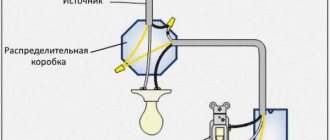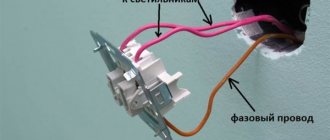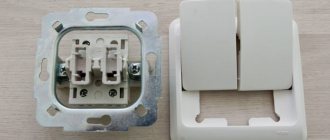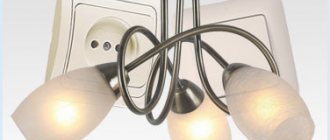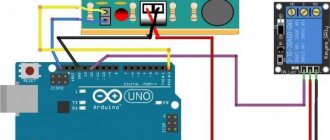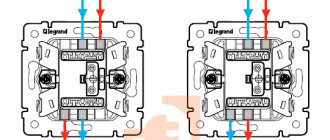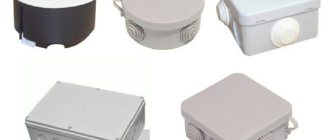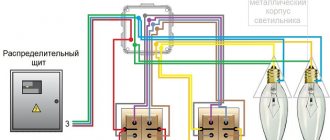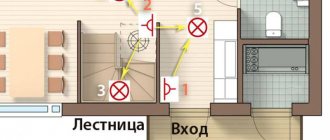2 types of switches used to turn on lights from several places. Practice connecting a two-key cross switch. TOP 5 installation errors. TOP 5 manufacturers and TOP 5 questions from readers.
A switch is used to turn on the light. But it has a drawback - it can be turned on only from one place. To solve this problem, pass-through and crossover switches are used.
They are installed individually or together with conventional switches and sockets. In addition to the traditional form, push-button, there are manufacturers that produce devices that are turned on by turning a handle.
Wiring diagram for a switch in an apartment
TEST:
A 4-question test on knowledge of circuits and devices for controlling light from several places.
Take a test on knowledge of systems for turning on light from several places.
- From how many places can you turn on the light?
a) of two
b) from any quantity when using switches of different designs
- Can intermediate switches be used instead of pass-through switches?
a) yes, when installing the appropriate jumpers
b) no
- What wires are used for connection?
a) any of the appropriate cross-section, but a cable with cores in multi-colored insulation is more convenient
b) only special ones
- Is it possible to install switches to turn on lights from several places in one row and cover them with a common decorative panel with regular sockets and switches?
a) no
b) yes, if you use equipment from the same manufacturer and series.
Test results:
- b, a, a, b - you know enough for independent design and installation;
- a, b, b, a - your knowledge is not enough for independent work;
- the rest of the results - you have knowledge, but it needs to be improved by reading articles and watching videos on the Internet.
Operation of the circuit with 3 types of switches - regular, through and cross
The cross switch is used in light control systems with 3 or more places. The device is so called because when switching, it swaps the connections of the suitable wires to the outgoing wires - in a crisscross pattern.
Look at the diagram in the picture
light control using pass-through and cross switches. In a conventional device, there are two contacts for controlling light from one place. Closing and opening them turns the lamp on and off. Therefore, the control key has the “on” and “off” positions marked with letters or icons, and two wires are connected to the device - one phase, from the network and the second from the lamp.
The system for controlling light from several places is designed differently. The device has three contacts - 2 fixed ones, to which the outgoing wires connecting the switches are connected, and 1 movable one. A wire going to the phase or lamp is connected to it. The on position of the circuit is when both devices are connected to the same wire, so there is no “on” position on the keys.
Lighting control circuit from three places
The connection diagram for two-key devices consists of two parallel circuits, one for each lamp. They are connected only by connecting a suitable wire on the first pass-through switch.
Connection diagram for two-button switches
What does a single-key cross switch mean - 3 differences between the operating principle and the pass-through one
To control lamps from three or more places in the circuit, in addition to two pass-through ones, cross switches are used.
The operating principle and design of the crossover switch are similar to the pass-through switch. But there are a number of differences:
- two wires come instead of one;
- inside there are four fixed contacts and two movable ones, and not two and one, as in walk-through ones;
- both incoming wires are always connected to the outgoing ones, in contrast to a pass-through type, in which the outgoing wires are connected alternately.
When you press a key or turn a knob, this device reverses the wire connections. As a result, the second pass-through device is connected to the live or unconnected wire, which turns the light on or off.
Designation on switch diagrams
Installation instructions
Installation work is carried out in the following sequence:
- We lay and fix a two-core wire for connecting pass-through switches.
- We leave a small loop in the area where the cross switch is installed, but do not cut off the wire.
- We mount the switches in the desired places.
- We bring the ends of the conductors to the pass-through devices - two-wire, zero or phase.
- We test the network for the ability to control from two points.
- Turn off the power supply to the network.
- At the installation site of the crossover device, I will cut the two-core cable. We put a cross switch in the gap.
- We supply power.
- We check the network for operability with three control points.
For a cross-pass switch installed indoors, any insulated two-core cable with a cross-section appropriate for the load is suitable. For street lighting, double insulated conductors are used.
2 types of switches used to turn on lights from several places. Practice connecting a two-key cross switch. TOP 5 installation errors. TOP 5 manufacturers and TOP 5 questions from readers.
A switch is used to turn on the light. But it has a drawback - it can be turned on only from one place. To solve this problem, pass-through and crossover switches are used.
They are installed individually or together with conventional switches and sockets. In addition to the traditional form, push-button, there are manufacturers that produce devices that are turned on by turning a handle.
Read also: Tractor for felling forests
Wiring diagram for a switch in an apartment
Take a test to test your knowledge of light switching systems from multiple locations.
- From how many places can you turn on the light?
b) from any quantity when using switches of different designs
- Can intermediate switches be used instead of pass-through switches?
a) yes, when installing the appropriate jumpers
- What wires are used for connection?
a) any of the appropriate cross-section, but a cable with cores in multi-colored insulation is more convenient
- Is it possible to install switches to turn on lights from several places in one row and cover them with a common decorative panel with regular sockets and switches?
b) yes, if you use equipment from the same manufacturer and series.
Test results:
- b, a, a, b - you know enough for independent design and installation;
- a, b, b, a - your knowledge is not enough for independent work;
- the rest of the results - you have knowledge, but it needs to be improved by reading articles and watching videos on the Internet.
Why do you need a crossover switch along with 2 pass-through switches?
Conventional fixtures include lights from only one location, while a two-way system includes two lights, for example, at the two ends of a long corridor. Sometimes this is not enough and it is necessary to turn on the lights on each floor of the staircase of a multi-story building or at different ends of the room.
To do this, a system is installed in which pass-through devices are installed in two places, and with two changeover contacts in the rest.
If such a device is not available, it can be made from a two-key pass-through device.
Transfer switch in two places
Connection diagram for switch switch for 1, 2 and 3 keys
The connection diagram for such devices is more complex than conventional ones, so for error-free assembly you should draw a diagram.
Control scheme from two places
Light control circuit from three places, where 1 is a pass-through switch; 2 - cross switch; 3, 5 — socket boxes for pass-through switches; 4 - socket box for cross switch; 6 - branch box; 7 - to the lamp body
Three-location control scheme
Designation of 6 types of switches
On the diagrams, each type of electrical appliance has its own designation. Devices that turn off lights are no exception. The following figure shows the symbols used to mark different types of switches in the diagrams.
Symbols of single-pole switches
They also differ in the pattern on the outer key.
Cross switch - 2-point connection diagram
To control lighting from two points, there is no need to install a device with two changeover contacts. To do this, it is enough to use two pass-through devices. The connection diagram is drawn up so that a phase wire is connected to the moving contact of one of them, a lamp to the other, and the fixed contacts are connected in pairs by two wires.
How to connect a crossover switch with single-key pass-through switches - connection diagram for a crossover switch from 3 places
To control light from three or more places, intermediate switches are needed. Pass-through devices are installed at the beginning and end of the chain, and intermediate devices are installed in other places. Their number is 2 less than the number of switching points. Such devices are inserted into the gap of two wires connecting the pass-through switches.
Cross two-gang switch
Connection diagram for 2-key switch switch
A cross 2-key device differs in that it has two keys and two groups of contacts. In fact, these are two switches in one housing.
If in conventional two-key devices the moving contacts are connected by a built-in jumper to which the phase wire is connected, then in intermediate and through ones they are not interconnected. This is shown in a diagram that shows two independent parallel lines. The only place where they are connected is a jumper on the moving contacts of the first device.
Diagram of 2 crossover contacts
When controlling lighting from several places, the switches are connected by two wires. The light turns on only when all switches include the same wire in the circuit. The main task of a device with two changeover contacts is to swap wire connections. For this purpose, appropriate jumpers are installed inside the device.
Diagram of 2 contact cross switches
Types of switches
There are two types of crossover switches: rocker and rotary.
Devices of this type are the most common. Switches break one circuit and close another. Standard devices work with only one circuit.
Externally, different types of switches differ in the following characteristics:
- single-key cross switch has 2 contacts;
- pass-through - 3 contacts;
- cross - 4 contacts.
The devices are equipped with one, two or three keys. Three-key and two-key cross switches are used to independently control multiple circuits.
Rotary cross
Switches of this type are not so widespread. They are used to control light in industrial and warehouse buildings, and to organize street lighting. Less commonly, rotary cross devices are used in residential premises. Closing and opening of contacts is carried out by moving the lever.
Overhead and built-in
Based on the installation method, switches are usually divided into two types - built-in and surface-mounted. Built-in models are installed at the stage of building construction or during the process of replacing box parts. Conductors are laid in wall channels or fixed to the walls. After this, the wires are covered with a layer of plaster or other finishing material.
Overhead devices are fixed to the wall. In this case, there is no need for special channels. Surface mounted switches are not very convenient as they are susceptible to contamination. However, overhead models fit well into modern interiors.
Make 2 types of switches with your own hands - cross-cut and pass-through
It is not always possible to purchase an intermediate switch of the required design. In this case, you can do it yourself.
How to make a crossover from a 2-key pass-through
In order to convert a two-key pass-through switch into an intermediate one, it is necessary to install jumpers on the terminals connected to the fixed contacts of the different halves of the device, and they must be installed crosswise - right to left, and left to right.
The disadvantage of this modification is that both keys must be turned on simultaneously. In some models, the keys can be connected to each other or a single key removed from a single-key switch can be installed. In this case, the remaining device will have to be thrown away.
Remaking a 2-key conventional switch in a walk-through switch
If necessary, you can also convert a conventional two-key electric switch of some models into a walk-through switch with your own hands. To do this, you need to disassemble it and rotate the contact group 180 degrees. Then, instead of two keys, close the device with a key removed from a single-key device.
Conversion of a 2-key conventional switch into a walk-through switch
Types of switches
According to their design, cross switches are divided into 2 types: key and rotary.
Switches of this type are most often used.
Key switches, or more correctly called switches, break one circuit and close another. Conventional switches only open or close one circuit. Externally, they are practically the same. They can only be distinguished from the back by the number of contacts:
- a regular single-key has 2 contacts;
- at the passer -3;
- the cross one has 4.
Differences between regular, pass-through and cross single-key switches (photo gallery)
Key switches can have 1, 2 or 3 keys. Multi-key switches are designed to control multiple circuits independently.
Rotary cross
Switches of this type are installed less frequently than keyboard switches. They are usually used in warehouses and industrial premises, for street lighting, and as interior decoration in apartments. The contact groups in them are closed and opened by turning the lever.
Appearance of rotary switches (photo gallery)
Overhead and built-in
According to the installation method, switches are divided into 2 types: overhead and built-in.
Built-in switches are installed during the construction or renovation stage in boxes installed in niches. The wires are laid in grooves or attached to the walls. Typically, this method is used before plastering walls or covering them with plasterboard or other materials.
Surface-mounted switches and their associated wires are attached to the wall. In this case, there is no need to scratch the walls and knock out recesses for the boxes. They are usually installed in this way during cosmetic renovations. Overhead switches create certain inconveniences: dust accumulates on them, people cling to them while moving. In some cases, owners, on the contrary, prefer this type of switches for interior design.
Characteristics of cross switches
The electrical products market has a wide selection of switches and switches from domestic and foreign manufacturers. The difference in price between different manufacturers is significant, but the dimensions and technical characteristics are similar.
Connecting 2 types of switches
When connecting, it is important to do this according to the diagram. If installation errors occur, the system will not work correctly - it will not turn on, will not turn off, or only some switches will work.
The following picture shows the connection of a single-key switch with two contacts.
Connecting a two-pin single-key switch
This completes the connection of the pass-through switch.
Connecting a pass-through switch
Important! High voltage is life threatening. Therefore, all work must be carried out with the input machine turned off.
Necessary equipment and materials
- Switches
- Mounting box
- Electrical insulating tape
- Terminals
- Phillips and regular screwdrivers
- Installation knife
- Side cutters
- Pliers
- Wrenches
- Electric cable
If the room has already been wired and you need to install redundant switches, then you need to make grooves or open installation of cables.
In order to make grooves you will need a hammer drill and a wall chaser. You also need alabaster. He will secure the corrugated pipe.
In case of open installation, a distribution box is required; it is attached to the wall using a corrugated pipe.
How to avoid 5 installation mistakes
There are mistakes that inexperienced electricians make when laying and connecting wires:
- The neutral wire is connected to the first switch. Before connecting, you should use a tester to find the phase wire.
- Instead of a pass-through switch, an intermediate switch with two changeover contacts and jumpers is installed. This is a valid option, but such devices are more expensive.
- Use instead of special conventional switches. This scheme will not work. You need to take the necessary devices.
- Incorrect wire connection. Before starting work, draw a connection diagram and mark the wires.
- Strip the ends of wires that are not long enough. Such ends do not hold well and fall out of the terminal. They should be stripped to a length of 8mm.
Operating principle
Below is a diagram for connecting intermediate switches, providing independent switching on and off of lights from two different places.
Zero is connected directly to the lighting device, the phase is connected through a pair of switches connected by a two-wire conductor. With two switches PV1 and PV2, the first and third contacts close, as a result the circuit is closed, and electricity flows into the lamp.
A crossover switch is similar to a regular single-key switch, the only difference being the presence of four terminals inside. The crossover is named because the two electrical lines it switches are connected into a cross.
The cross disconnector simultaneously disconnects the first and second switches, then connects them synchronously. This movement of the contacts causes the light to turn on and off.
Advice! Pay special attention to the correct connection of the ends of the electrical cables, otherwise the entire system will not work.
The number of points may vary, but the more there are, the more difficult the switching in the distribution box. It is necessary to clearly mark the wires when conducting them so as not to confuse them.
Answers to 5 Frequently Asked Questions
There are questions that people ask when choosing such systems:
- How many wires do the switches need?
To ordinary switches 2, to pass-through switches 3, to cross-switches 4. When controlling two lamps (two-key switches) to ordinary 3, pass-through 5 to the first and 6 to the last, 8 to intermediate ones. - How many places can it be controlled from?
When using devices of both types - from any quantity. - What lamps can be connected to switches?
Any household lamps, household fans and, through an intermediate starter, electric heating systems. - What wires are used to connect?
Any appropriate cross-section, but preferably, for ease of installation, a ball-and-socket type with the appropriate number of cores. - What voltage are these devices designed for?
For any, up to 220V.
Top 5 manufacturers
NESSEN switch
Equipment produced by any company differs in price, quality and range. But there are manufacturers whose products are especially popular:
- Cross switches from the Turkish company Vico. Connecting these devices is similar to connecting devices from other factories. The products of this company are distinguished by their quality and affordable price. All parts are made from high-quality materials and are controlled at all stages of production.
- German company Gira. The products are of high quality and wide range.
- Cross switches from the French company Schneider Electric (“Schneider Electric”). The Schneider cross-switch circuit is similar to equipment circuits from other companies.
- Cross switches from the Swedish-Swiss company ABB (Asea Brown Boveri Ltd). The company produces equipment for electrical engineering and power engineering. The connection diagram for the ABB crossover switch does not differ from the connection diagrams for equipment from other companies.
- Switches from the French company Legrand are distinguished by their wide range and reliability. You can note the two-key (double) cross switch Legrand Valena and Legrand Ethics. The connection and diagram of the Legrand double crossover switch are similar to the connection and diagram of devices from other manufacturers.
The following figure shows the assembly of Legrand Valena, a two-key crossover switch.
Legrand Valena assembly
Information! Equipment manufactured by any company is installed and connected in a similar way.
